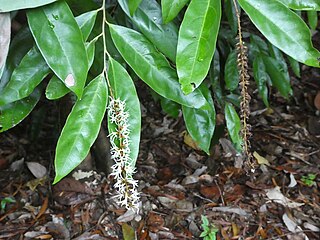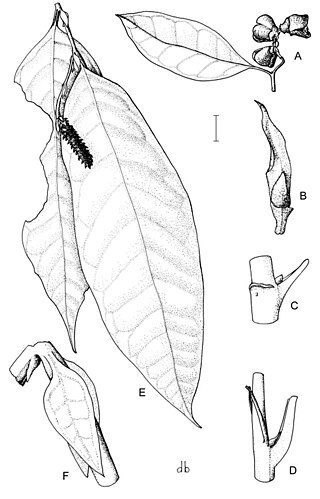
Helicia australasica, also known as Austral oak or creek silky oak, is a species of rainforest tree in the macadamia family Proteaceae, native to New Guinea and northern and northeastern Australia.

Neostrearia is a monotypic genus - i.e. a genus containing only one species - of plants in the witch-hazel family Hamamelidaceae. It is the second described of three monotypic Australian genera in this family, the others being Ostrearia and Noahdendron. It is most closely related to these genera, as well as Trichocladus from southern Africa and Dicoryphe from Madagascar, and together these five genera form a distinct clade within Hamamelidaceae.

Ostrearia is a monotypic genus - i.e. a genus containing only one species - of plants in the witch-hazel family Hamamelidaceae. It is the first described of three monotypic Australian genera in this family, the others being Neostrearia and Noahdendron. It is most closely related to these genera, as well as Trichocladus from southern Africa and Dicoryphe from Madagascar, and together these five genera form a distinct clade within Hamamelidaceae.

Noadendron is a monotypic genus - i.e. a genus containing only one species - of plants in the witch-hazel family Hamamelidaceae. It is the third described of three monotypic Australian genera in this family, the others being Ostrearia and Neostrearia. It is most closely related to these genera, as well as Trichocladus from southern Africa and Dicoryphe from Madagascar, and together these five genera form a distinct clade within Hamamelidaceae.

Diploglottis harpullioides, commonly known as Babinda tamarind, is a rainforest tree in the lychee and maple family Sapindaceae which is found only in northeast Queensland, Australia.

Fagraea fagraeacea, commonly known as yellowheart or pink jitta, is a plant in the gentian family Gentianaceae which is native to New Guinea and Queensland.

Cupaniopsis flagelliformis, commonly known as brown tuckeroo or weeping flower tamarind, is a tree in the lychee and maple family Sapindaceae endemic to eastern Australia. It is a small tree that inhabits drier or seasonal rainforests.

Gillbeea adenopetala, commonly known as Pink alder, is an evergreen tree in the largely southern hemisphere family Cunoniaceae. It was first described in 1865 and is endemic to a small part of Queensland, Australia.

Diploglottis bernieana, commonly known as Bernie's tamarind or large leaf tamarind, is a plant in the maple and lychee family Sapindaceae. It was first described in 1987 by the Australian botanist Sally T. Reynolds and is found only the Wet Tropics region of northeastern Queensland, Australia.

Peripentadenia mearsii, commonly known as the buff quandong or grey quandong, is a plant in the family Elaeocarpaceae endemic to a small part of northeastern Queensland, Australia. It is usually seen as a multistemmed tree, and the habitat is tropical rainforest.

Aglaia ferruginea, commonly known as rusty boodyarra or rusty Aglaia, is a plant in the mahogany family Meliaceae that is native to northern Queensland, Australia. The name A. tomentosa has been misapplied to the species in the past.

Debregeasia australis, commonly known as china grass or native ramie, is a plant in the nettle family Urticaceae endemic to Queensland, Australia.

Peperomia enervis is a plant in the pepper family Piperaceae found only in rainforests of northeast Queensland near the cities of Cairns and Mackay. It was first described in 1891.

Lepiderema sericolignis, commonly known as silkwood, is a plant in the maple and lychee family Sapindaceae found only in the Wet Tropics bioregion of Queensland, Australia.

Diploglottis smithii, commonly known as Smith's tamarind or wild tamarind, is a plant in the maple family Sapindaceae found only in the Wet Tropics bioregion of Queensland, Australia.

Psychotria coelospermum is a small climbing plant in the coffee family Rubiaceae found only in the Northern Territory and Queensland, Australia. The leaves are paired and measure up to 14 cm long by 7 cm wide. Flowers are produced in panicles from October to December, followed by white fruits about 15 mm diameter from February to June. It grows in swamps and very wet areas in rainforest.

Syzygium alatoramulum, commonly known as tinkling satinash, is a plant in the clove and eucalyptus family Myrtaceae, found only in the Wet Tropics bioregion of Queensland, Australia.

Syzygium graveolens, commonly known as cassowary satinash, is a plant in the eucalyptus family Myrtaceae found only in the Wet Tropics bioregion of Queensland, Australia.

Balanops australiana, commonly known as pimplebark, is a plant in the family Balanopaceae found only in the coastal regions of northern and central Queensland, Australia.

Garuga floribunda, commonly known as garuga, is a plant in the frankincense and myrrh family Burseraceae, with a broad distribution from northeastern India through southeast Asia and northern Australia to the southwestern Pacific. It is a tree up to 36 m (118 ft) tall and a trunk diameter up to 90 cm (35 in). The compound leaves are about 38 cm (15 in) long, arranged spirally and clustered near the tips of the branches. The leaflets are odd in number, with dentate margins, and measure up to 10 cm (3.9 in) long by 5 cm (2.0 in) wide.





















